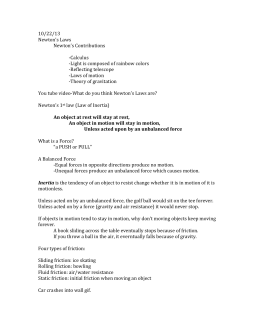Physics Classroom Newtons Laws Solution Guide
Newton's Third Law: Complete Toolkit Contributor The Physics Classroom, Tom Henderson Type Category Assessment Materials Instructional Materials Types Simulation, Interactive Simulation, Problem Set, Graph, Informative Text, Animation/Movie, Experiment/Lab Activity, Activity Note This resource, vetted by NSTA curators, is provided to teachers along with suggested modifications to make it more in line with the vision of the NGSS. While not considered to be “fully aligned,” the resources and expert recommendations provide teachers with concrete examples and expert guidance using the EQuIP rubric to adapted existing resources. This is a collection of activities and links on the Physics Classroom website, about Newton’s Third Law of Motion. Many of these directly reference objects' behavior during collisions.
Some of the materials are created by the Physics Classroom themselves; others are links to further resources. The materials are categorized by type (reading, videos, labs and investigations, demonstrations, internet modules, concept builders, real life connections, and common misconceptions).
Newton's Laws of Motion: Problem Set. Determine the weight of an African elephant in Newtons and in pounds. Audio Guided Solution. Physics Classroom Newtons Laws Solution Guide. Library Download Book (PDF and DOC) Yale L83c Manual Informatica Power Exchange Manual Manual Do Usuario Cb500x. False - Inertia is not a force. False - Inertia is NOT a force. False - Inertia is NOT a force. Inertia is simply the tendency of an objects to resist a.
Each link is accompanied by a short blurb about the material and the Physics Classroom’s suggestions for use. This resource appears to be designed to build towards this performance expectation, though the resource developer has not explicitly stated so. Comments about Including the Performance Expectation Materials linked on this page run the gamut from introductory Third Law to advanced applications. Many of the materials that do not directly relate to collisions will be useful as introductions to what the Law is about and how it works, and will act as scaffolding toward students’ ability to meet the performance expectation.

Several of the materials do directly focus on collisions.These include Physlet Physics: Newton’s Third Law – Contact Forces,Rutgers University Learning Cycle: Newton’s Third Law, University of Pennsylvania: Forces and Newton’s Laws, The Physics Classroom's Third Law on YouTube 10-second Demonstration, the Minds On Physics Internet Module, the Curriculum Corner Newton’s Third Law, and the Science of NFL Football. This resource appears to be designed to build towards this science and engineering practice, though the resource developer has not explicitly stated so.
Comments about Including the Science and Engineering Practice This collection is ideal for the practice of integrating information, as the resource offers a variety of modalities, including informational text, video clips, graphs, and simulations. A teacher can choose several of the provided materials for the students to explore, and create a culminating task that requires the student to draw upon their findings from the various materials. If used as part of a final assessment, the culminating task could be to predict the outcome of a given collision, and use evidence from the various materials to support the claim about the outcome. This resource appears to be designed to build towards this crosscutting concept, though the resource developer has not explicitly stated so.
Comments about Including the Crosscutting Concept The specific language of cause and effect is not part of the wording of Newton’s Third Law, so a teacher will need to make that connection overt. Use caution: a common misconception about the Third Law involves the idea that the “action” comes first, followed by the “reaction”.
Inertia
Be sure to clarify the difference between cause-effect and force pairs. Some of the materials in the collection specifically ask students to make predictions, including “Physlet Physics - contact forces” and “Rutgers University Learning Cycle - Newton’s Third Law”. Other materials, particularly video clips and simulations, can be modified for use in prediction-making. E.g., pause any of the video clips partway through and ask “what do you think will happen now?”; set parameters for a simulated collision and ask students to predict an outcome before playing the simulation.

Resource Quality. Alignment to the Dimensions of the NGSS: This collection provides a variety of materials, which allows for a teacher to choose those best suited for his/her class and area of NGSS focus. Materials in the collection support a disciplinary core idea, practice, and cross-cutting concept, as detailed above. Due to the variety offered, a teacher could also easily choose a set of activities to highlight a different practice and/or a different cross-cutting concept.
Because the resource is a collection, classes have multiple opportunities to investigate a variety of phenomena, including football, jet packs, roller skates, air tracks, and colliding blocks, via a variety of modalities (reading, video clips, simulation, discussions, demonstrations, and labs). Instructional Supports: Although this collection is not a lesson plan or a unit plan, the activities offer opportunities for instructional support. Differentiation is possible through teacher or student selection of different materials. Concept support is available for those who need it, and more “advanced” activities are available, originally intended for high school use, but appropriate for middle school students with higher math and/or language arts skills. The collection includes a real-world connection section, and several of the videos and activities in other sections may also be relatable to students’ own experiences. This collection does not assess or build on students’ prior knowledge, nor does it specifically direct students to communicate and support their ideas and findings.
Monitoring Student Progress: This resource is not a lesson or unit, so it does not include suggestions for monitoring student progress. Some of the materials include student questions, which a teacher could use as formative or summative assessment. Quality of Technological Interactivity: The resource itself, and most of the materials provided on it, are not technologically interactive. A few of the materials offer computer questions with immediate feedback; these are not individualized. The interactive simulation is individualized by nature, though may not be intuitive to use.